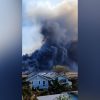A spacecraft left behind by US astronauts on the lunar surface could be causing small tremors known as moonquakes, according to a new study.
Researchers revealed the previously unknown form of seismic activity on the moon for the first time through an analysis of Apollo-era data using modern algorithms.
Massive temperature swings that occur on the moon can cause human-made structures to expand and contract in a way that produces these vibrations, the report suggests. The lunar surface is an extreme environment, oscillating between minus 208 degrees Fahrenheit (minus 133 degrees Celsius) in the dark and 250 degrees Fahrenheit (121 degrees Celsius) in direct sun, according to a news release about the study.
In fact, the entire surface of the moon expands and contracts in the cold and heat, noted the study published September 5 in the Journal of Geophysical Research: Planets. Yet scientists were able to use a form of artificial intelligence to gain such an intimate understanding of the Apollo-era data that they could pinpoint gentle tremors that emitted from an Apollo 17 lunar lander module sitting a few hundred yards away from instruments recording the moonquakes, according to a synopsis of the study by researchers from institutions including the California Institute of Technology and NASA. (NASA provided funding for the study.)
The analysis offers new insights into how the moon responds to its surroundings and what can affect its seismic activities. The rumbles were not dangerous and likely would be imperceptible to humans standing on the moon’s surface.
Understanding moonquakes could be essential to future exploration, experts said, should NASA and its partners build a permanent outpost on the moon’s surface — a goal of Artemis, the agency’s lunar exploration program.
“How strong do we need to build our structures, and what other hazards do we need to mitigate for?” Dr. Angela Marusiak, an assistant research professor at the University of Arizona’s Lunar and Planetary Laboratory, said of the questions that this type of data analysis can help answer. Marusiak was not directly involved in the study, though she did have contact with the authors as a fellow expert in lunar seismology.
Mining for moonquakes
Marusiak noted that every Apollo mission carried instruments for detecting moonquakes. But the Apollo 17 mission, launched in 1972, was noteworthy because it left behind an array of seismometers capable of detecting thermal moonquakes — or the tremors induced by the drastic heating and cooling of the lunar surface.
“Thousands of these signals were recorded during an 8-month span from 1976 to 1977 on four seismometers deployed during the Apollo 17 Lunar Seismic Profiling Experiment, but the poor quality of data makes analysis difficult,” the researchers wrote. “We developed algorithms to accurately determine the arrival timing of the waves, measure the strength of the seismic signal, and find the direction of the moonquake source.”
Scientists revisited the data for the first time in decades. The fresh analysis allowed the research team to conclude that a certain type of moonquake — called an impulsive thermal moonquake — did not come from natural sources but rather from the nearby spacecraft heating and cooling.
“Every lunar morning when the sun hits the lander, it starts popping off,” said study coauthor Allen Husker, a research professor of geophysics at Caltech, in a statement. “Every five to six minutes (there was) another one, over a period of five to seven Earth hours. They were incredibly regular and repeating.”
These tremors differed from another type of moonquake, called emergent thermal moonquakes, that are likely caused by the ground’s natural reaction to sunlight exposure, according to the study.
Other seismic activity
The researchers said they are hopeful that future lunar missions will offer an even more holistic picture of the phenomena.
Apart from thermal quakes, the moon has also been known to have deep and shallow tremors as well as activity believed to be caused by meteorite strikes.
It’s important to note a key difference between the moon and Earth: On the lunar surface, there are no shifting tectonic plates that might cause catastrophic events. But the moon has an active interior life, and — like Earth — certain types of seismic events can occur at any time or location on the lunar surface, Marusiak said.
Marusiak was keen about India’s lunar lander mission, Chandrayaan-3, which included a seismometer. Already, the Indian Space Research Organization has confirmed that the instrument was able to detect a moonquake. (ISRO researchers have not yet released extensive data on the recording or proposed a suggested cause of the event.)
The Chandrayaan-3 instrument, which recorded activity near the lunar south pole for the first time, was put to sleep in early September. Researchers will attempt to awaken the spacecraft for further data collection on September 22, when the Chandrayaan landing site reenters sunlight.
“I’m hoping that with the Artemis program, seismometers will continue to be included because they are really vital for understanding what goes on, not just at the very surface, but even deeper down into the regolith (soil),” Marusiak said.
But scientists are enthusiastic that poring through Apollo-era data with modern technology can yield fascinating new results.
“It’s important to know as much as we can from the existing data so we can design experiments and missions to answer the right questions,” Husker said. “The Moon is the only planetary body other than the Earth to have had more than one seismometer on it at a time. It gives us the only opportunity to thoroughly study another body.”







































